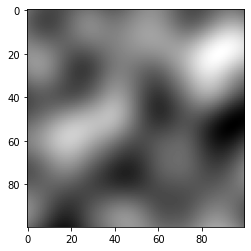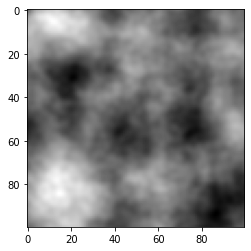Smooth random noise generator
read more https://en.wikipedia.org/wiki/Perlin_noise
source code: https://github.com/salaxieb/perlin_noise
noise = PerlinNoise(octaves=3.5, seed=777)
octaves : number of sub rectangles in each [0, 1] range
seed : specific seed with which you want to initialize random generator
tile_sizes : tuple of ints of you want to noise seamlessly repeat itself
from perlin_noise import PerlinNoise
noise = PerlinNoise()
noise(0.5) == noise([0.5])
noise([0.5, 0.5]) == noise([0.5, 0.5, 0, 0, 0])
noise([0.5, 0.5], tile_sizes=[2, 5]) == noise([2.5, 5.5], tile_sizes=[2, 5])
Usage examples:
import matplotlib.pyplot as plt
from perlin_noise import PerlinNoise
noise = PerlinNoise(octaves=10, seed=1)
xpix, ypix = 100, 100
pic = [[noise([i/xpix, j/ypix]) for j in range(xpix)] for i in range(ypix)]
plt.imshow(pic, cmap='gray')
plt.show()

import matplotlib.pyplot as plt
from perlin_noise import PerlinNoise
noise1 = PerlinNoise(octaves=3)
noise2 = PerlinNoise(octaves=6)
noise3 = PerlinNoise(octaves=12)
noise4 = PerlinNoise(octaves=24)
xpix, ypix = 100, 100
pic = []
for i in range(xpix):
row = []
for j in range(ypix):
noise_val = noise1([i/xpix, j/ypix])
noise_val += 0.5 * noise2([i/xpix, j/ypix])
noise_val += 0.25 * noise3([i/xpix, j/ypix])
noise_val += 0.125 * noise4([i/xpix, j/ypix])
row.append(noise_val)
pic.append(row)
plt.imshow(pic, cmap='gray')
plt.show()

Library has a possibility to generate repetative random noise with custom tile sizes:
import matplotlib.pyplot as plt
from perlin_noise import PerlinNoise
noise = PerlinNoise(octaves=2, seed=42)
xpix, ypix = 800, 1200
lim_x, lim_y = 6, 9
pic = [
[
noise([lim_x * i / xpix, lim_y * j / ypix], tile_sizes=[2, 3])
for j in range(xpix)
]
for i in range(ypix)
]
plt.imshow(pic, cmap="gray")
plt.show()

import matplotlib.pyplot as plt
from perlin_noise import PerlinNoise
noise1 = PerlinNoise(octaves=1)
noise2 = PerlinNoise(octaves=3)
noise3 = PerlinNoise(octaves=6)
noise4 = PerlinNoise(octaves=12)
xpix, ypix = 800, 1200
lim_x, lim_y = 4, 6
tile_sizes = (2, 3)
pic = []
for i in range(ypix):
row = []
for j in range(xpix):
noise_val = noise1([lim_x * i / xpix, lim_y * j / ypix], tile_sizes)
noise_val += 0.5 * noise2([lim_x * i / xpix, lim_y * j / ypix], tile_sizes)
noise_val += 0.25 * noise3([lim_x * i / xpix, lim_y * j / ypix], tile_sizes)
noise_val += 0.125 * noise4([lim_x * i / xpix, lim_y * j / ypix], tile_sizes)
row.append(noise_val)
pic.append(row)
plt.imshow(pic, cmap="gray")
plt.savefig("pics/multy_noise_tiled.png", transparent=True)
plt.show()

for tiles to work correctly, number of octaves MUST be integer
import matplotlib.pyplot as plt
from perlin_noise import PerlinNoise
noise = PerlinNoise(octaves=2.5, seed=42)
xpix, ypix = 800, 1200
lim_x, lim_y = 6, 9
pic = [
[
noise([lim_x * i / xpix, lim_y * j / ypix], tile_sizes=(2, 3))
for j in range(xpix)
]
for i in range(ypix)
]
plt.imshow(pic, cmap="gray")
plt.savefig('pics/tiled_with_step.png', transparent=True)
plt.show()









